
The Calder Valley line is a railway route in Northern England between the cities of Leeds and Manchester as well as the seaside resort of Blackpool. It is the slower of the two main rail routes between Leeds and Manchester, and the northernmost of the three main trans-Pennine routes.

The Huddersfield line is the main railway line between the English cities of Leeds and Manchester, via Huddersfield. It is one of the busiest MetroTrain lines. The route travels south-south-west from Leeds through Dewsbury. After a short westward stretch through Mirfield, where it runs on the ex-L&YR section, it continues south-west through Huddersfield, using the Colne Valley to its headwaters. The long Standedge Tunnel, just after Marsden, crosses under the watershed; the majority of the run down to Manchester is in the Tame Valley. From Manchester, some services continue to Manchester Airport and others to Liverpool.
The North Western Railway (NWR) was an early British railway company in the north-west of England. It was commonly known as the "Little" North Western Railway, to distinguish it from the larger London and North Western Railway (LNWR).
The Ashton, Stalybridge and Liverpool Junction Railway was opened in 1846 to connect the industrial town of Ashton-under-Lyne to the developing railway network, and in particular to the port of Liverpool. It was a short line, joining the Manchester and Leeds Railway at Miles Platting and the connection to Liverpool was over that line and the Liverpool and Manchester Railway.

Mirfield railway station serves the town of Mirfield in West Yorkshire, England. It lies on the Huddersfield Line and is managed by Northern and also receives services by Grand Central and also TransPennine Express. The station is 4 miles (6 km) north east from Huddersfield.
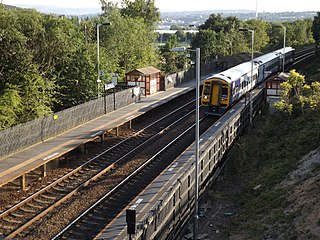
Deighton railway station serves the Deighton area of Huddersfield, West Yorkshire, England.

Guisborough railway station was the terminus of the Middlesbrough and Guisborough Railway. It served the town of Guisborough in North Yorkshire, England. The station was opened to goods in November 1853, and to passenger traffic on 25 February 1854. The station was closed to passengers, along with the entire Nunthorpe–Guisborough branch, on 2 March 1964, with freight being lost in August 1964.
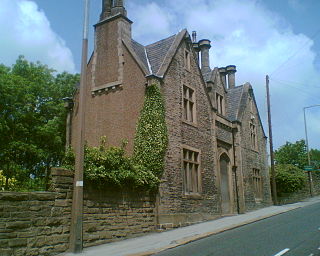
The Holmfirth branch line is a disused railway line that ran for 2 miles (3.2 km) from Brockholes to Holmfirth, in West Yorkshire, England. The line was built as double track as there were plans to extend the line up the Holme Valley.
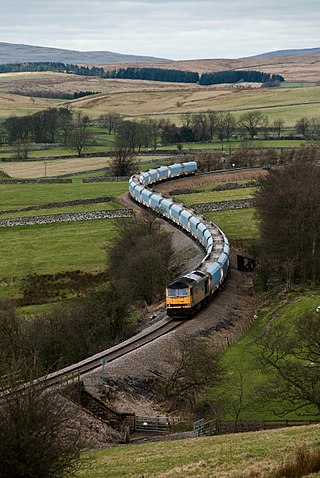
The Yorkshire Dales Railway was a branch line linking the town of Skipton with the villages of Rylstone, Threshfield and Grassington in North Yorkshire, England. There were two stations on the line – Grassington & Threshfield and Rylstone – and a connection via the Skipton to Ilkley Line to Skipton.

Thongs Bridge railway station was the only intermediate stop on the railway line between Brockholes and Holmfirth, West Yorkshire, England. Opened in July 1850, the station was temporarily closed in 1865 due to the collapse of Mytholmbridge Viaduct. The station closed to passengers permanently in 1959, closing completely in 1965.

Kirkheaton railway station served the village of Kirkheaton, West Yorkshire, England until closure in 1930. It was located immediately north of the junction of Crossley Lane and School Lane, and was accessed from the latter. The line continued towards Kirkburton on a bridge across School Lane.
Kirkburton railway station served the village of Kirkburton, West Yorkshire, England until closure in 1930.

The Heaton Lodge and Wortley Railway was constructed by the London and North Western Railway, to provide a duplicate route between Huddersfield and Leeds, leaving the existing line at Heaton Lodge Junction, east of Huddersfield and rejoining it at Farnley junction, south west of Leeds. During construction it became known as the Leeds New Line and following nationalisation it was referred to as the Spen Line. Passenger services ceased in the 1950s with full closure in stages between 1960 and 1990.
Lamplugh railway station was built by the Whitehaven, Cleator and Egremont Railway. It served the scattered community of Lamplugh, Cumbria, England.
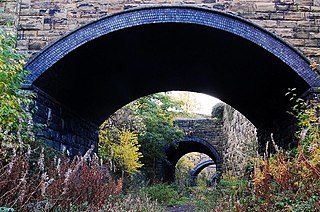
Heckmondwike Spen was a railway station opened by the London & North Western Railway (LNWR) in Heckmondwike, West Yorkshire, England. The station was one of two in the town of Heckmondwike, the other being Heckmondwike railway station which was opened by the Lancashire & Yorkshire Railway (L&Y). Both stations have been closed and the lines they served have closed too although the formations that they occupied have both been converted into greenways.

Meltham railway station was the terminus of the Meltham branch line from Lockwood (Huddersfield) to Meltham, in the West Riding of Yorkshire, England. Traffic partially started in 1868, but became regular in July 1869. The station, and line, were opened by the Lancashire & Yorkshire Railway (L&YR), later becoming part of the London Midland Scottish Railway. The station closed to passengers in 1949, though the branch remained open to freight until the 1960s. The railway station site is now the location of a supermarket.

The Clayton West branch line was a standard gauge passenger and freight railway near Huddersfield, in West Yorkshire, England. The line was built by the Lancashire and Yorkshire Railway, opening to traffic in September 1879. Many proposals were considered to extending the line eastwards towards Darton, and then connecting to Barnsley, but these never came to fruition. In 1963, both stations on the line,, were listed for closure under the Beeching cuts, but the branch survived as a passenger carrying railway until 1983. The branch also forwarded coal from two collieries adjacent to the line, which maintained a freight service on the branch up until closure.

Heaton Lodge Junction is a railway junction on the Trans-Pennine line, which connects Manchester Piccadilly with Leeds via Huddersfield, and the Calder Valley Line through Sowerby Bridge to Wakefield. The line and junctions were historically important as they connected the industrialised areas of Lancashire and Yorkshire.
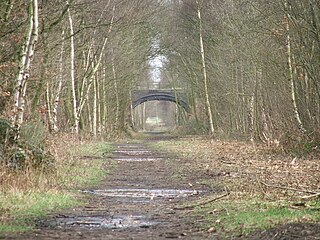
The Royston to Thornhill line was a Midland Railway venture constructed in West Yorkshire, England, that had the intent to allow trains to travel from Sheffield to Bradford without going through Leeds. The scheme, which was promoted as the West Riding Lines, would have travelled underneath Bradford city centre in a long tunnel and ended up in the Aire Valley providing a through line across Bradford. In the event, only the section from Royston to Thornhill, a smaller branch to a goods station at Dewsbury Savile Town, and a longer branch from Mirfield to Huddersfield were ever built. By the late 1960s, the lines had all been closed, however, the viaducts at Bradley, Crigglestone, and Horbury still remain.
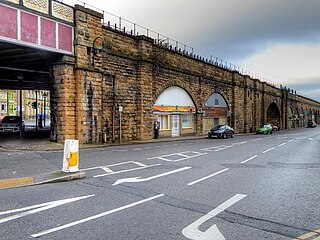
Huddersfield Viaduct is a railway bridge to the north-east of Huddersfield railway station in West Yorkshire, England. The viaduct carries the Huddersfield Line connecting Huddersfield with Dewsbury, Leeds, and York eastwards, and Manchester and Liverpool westwards. The viaduct was built to carry two lines, but was widened in the 1880s to take four tracks, and then reduced to two tracks in 1970. Huddersfield Viaduct is less well-known than other viaducts in the Kirklees area as they are higher, but Huddersfield Viaduct is the longest in the Kirklees district.

















